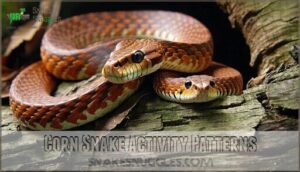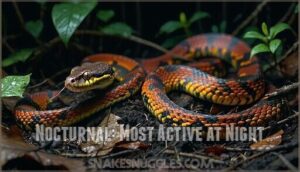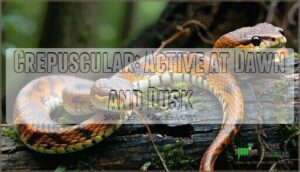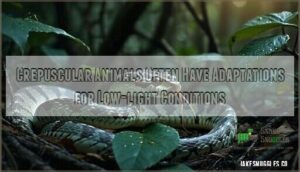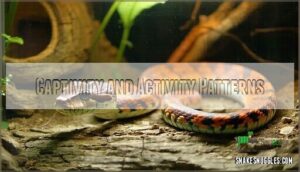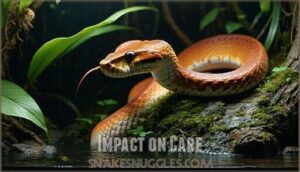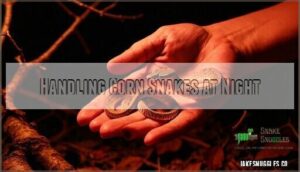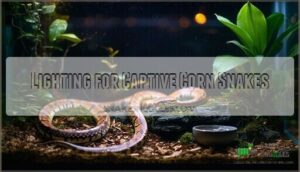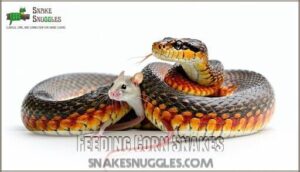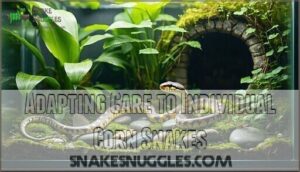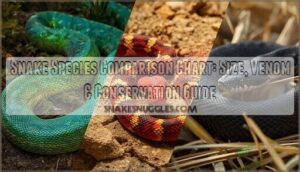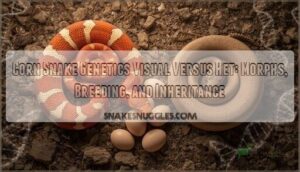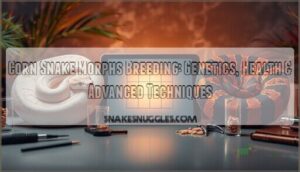This site is supported by our readers. We may earn a commission, at no cost to you, if you purchase through links.
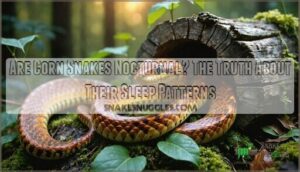
They’re actually crepuscular, meaning they’re most active during twilight hours at dawn and dusk.
Think of them as the "early bird and night owl" combo of the snake world.
While they do hunt and move around during these low-light periods, they spend most of their day and night resting.
In captivity, you’ll notice your corn snake becomes more animated when the sun’s setting or rising.
This behavior stems from their natural hunting instincts, as many of their prey animals are also active during these cooler, dimmer hours.
Understanding this pattern reveals important secrets about proper care timing.
Table Of Contents
- Key Takeaways
- Are Corn Snakes Nocturnal?
- Corn Snake Activity Patterns
- Differences Between Nocturnal and Crepuscular
- Factors Influencing Activity Patterns
- Captivity and Activity Patterns
- Impact on Care
- Handling Corn Snakes at Night
- Lighting for Captive Corn Snakes
- Feeding Corn Snakes
- Observing Corn Snake Behavior
- Adapting Care to Individual Corn Snakes
- Frequently Asked Questions (FAQs)
- Are corn snakes active at night?
- Are snakes nocturnal or diurnal?
- Do corn snakes sleep?
- Do corn snakes hunt at night?
- Are corn snakes active at dusk & dawn?
- Do corn snakes need a night light?
- What time of day are corn snakes most active?
- Do corn snakes sleep during the day?
- How to tell if a corn snake is stressed?
- Should I turn my corn snakes light off at night?
- Conclusion
Key Takeaways
- Your corn snake isn’t nocturnal—it’s crepuscular, meaning it’s most active during dawn and dusk hours when lighting conditions are perfect for hunting and avoiding predators.
- You’ll notice peak activity during twilight hours rather than throughout the night, as your snake follows natural patterns that optimize hunting success and temperature regulation.
- In captivity, you can adapt your care routine by timing feedings during dawn or dusk periods, using proper lighting cycles, and observing your snake’s individual activity preferences.
- Understanding this behavior helps you provide better care by recognizing normal patterns, timing interactions appropriately, and creating environmental conditions that match your snake’s natural crepuscular instincts.
Are Corn Snakes Nocturnal?
Let’s bust those Nocturnal Myths once and for all.
Your corn snake isn’t strictly nocturnal—it’s crepuscular, meaning it comes alive during dawn and dusk.
Your corn snake is a twilight hunter, perfectly timed for dawn and dusk adventures when the world dims.
This Activity Flexibility gives corn snakes Crepuscular Advantages for hunting while avoiding predators.
In Captivity Adaptations, you’ll notice your snake’s Individual Rhythms still follow this twilight pattern, making corn snake behavior predictably active during low-light hours.
Some snakes, unlike corn snakes, use heat-sensing pit organs for nocturnal hunting.
Corn Snake Activity Patterns
You’ll find that corn snakes aren’t strictly nocturnal creatures, but instead follow a crepuscular schedule that makes them most active during dawn and dusk hours.
Understanding these natural activity patterns helps you recognize normal behavior and create better care routines for your pet snake, which is crucial for providing optimal care.
Primarily Active at Dawn and Dusk (crepuscular)
Corn snakes follow crepuscular patterns, becoming most active during twilight hours when light dims.
Their peak activity occurs at dusk and dawn, perfectly timed for twilight hunting when prey emerges.
These crepuscular snakes have evolved specific adaptations for low-light conditions:
- Enhanced smell detection for navigation
- Heat-sensing abilities for prey location
- Camouflage coloring for protection
This corn snake behavior reflects millions of years of environmental influence on their sleep cycles.
Not Strictly Nocturnal
Many people assume corn snakes are strictly nocturnal, but this isn’t quite accurate. Your pet snake demonstrates crepuscular nature, being most active during twilight hours rather than deep night.
Captive adaptations allow for flexible activity patterns based on environmental influence and individual variation. Unlike purely nocturnal snakes, corn snake behavior adapts to your home’s lighting and temperature cycles.
Their behavior can also be influenced by environmental enrichment, like climbing branches.
- Activity patterns can shift throughout seasons, with warmer months potentially increasing nighttime movement while maintaining their core crepuscular snakes identity.
Differences Between Nocturnal and Crepuscular
Understanding whether corn snakes are nocturnal or crepuscular affects how you’ll care for your pet snake.
You’ll often hear people mix up these terms, but crepuscular animals like corn snakes prefer dawn and dusk hours, while nocturnal animals are most active at night.
Nocturnal: Most Active at Night
Understanding nocturnal behavior helps you recognize normal snake activity patterns.
Nocturnal animals concentrate their peak energy during nighttime hours, though they’re not exclusively active in darkness.
This lifestyle offers several advantages: nocturnal hunting provides access to prey that’s most vulnerable after sunset, heat regulation becomes easier in cooler night temperatures, and avoiding predators improves survival rates.
Some snakes, like rattlesnakes, use pit organs for hunting in complete darkness.
Activity Pattern Peak Activity Light Conditions
Light sensitivity influences these sleep patterns substantially.
Crepuscular: Active at Dawn and Dusk
Crepuscular animals are nature’s twilight specialists, perfectly timing their peak activity during dawn emergence and dusk retreat.
Your corn snake’s crepuscular adaptation means they’re wired for twilight hunting when lighting conditions create perfect camouflage.
These twilight hours offer ideal temperatures and prey availability, making corn snake behavior predictably active during morning and evening periods rather than full nighttime darkness.
Crepuscular Animals Often Have Adaptations for Low-light Conditions
Animals active during twilight hours possess remarkable sensory adaptations that help them navigate dim light conditions.
These twilight specialists have evolved incredible senses to thrive when most creatures struggle to see.
Your corn snake’s low-light vision allows precise hunting when most prey remains active but predators stay hidden.
- Enhanced thermal detection helps locate warm-blooded prey in darkness
- Heightened chemical receptors track scent trails more effectively
- Specialized retinal cells maximize available light for better visibility
These hunting strategies perfectly suit crepuscular lifestyles.
Many Animals Casually Described as Nocturnal Are Actually Crepuscular
You’d be surprised how often we mix up nocturnal and crepuscular when describing animal behavior.
Cats, dogs, deer, and rabbits get labeled as night creatures, but they’re actually most active during dawn dusk periods.
This nocturnal confusion stems from crepuscular misconceptions about activity patterns.
Their twilight adaptations optimize hunting and predator avoidance during low-light conditions, just like corn snake behavior demonstrates animal activity peaks at sunrise and sunset.
Factors Influencing Activity Patterns
Your corn snake’s activity schedule isn’t set in stone, and several environmental factors shape when it chooses to be most active.
Temperature changes, prey habits, predator threats, lighting conditions, and your snake’s own personality all work together to determine whether it’ll emerge during dawn, dusk, or somewhere in between, influenced by its unique personality.
Prey Availability
Your corn snake’s activity patterns shift based on prey availability in their environment. When rodents are scarce, they’ll hunt more actively during twilight hours.
Hunting success increases during these low-light periods when small mammals venture out. Scent tracking guides them to rodent burrows and hiding spots. As non-venomous constrictors, they suffocate their prey.
- Feeding frequency adjusts based on seasonal rodent size and abundance
- Dietary variety includes mice, rats, birds, and lizards depending on availability
- Nocturnal hunting behavior intensifies when prey is most active
- Corn snake behavior adapts to maximize encounters with available food sources
Predator Avoidance
Your corn snake’s survival toolkit includes clever predator avoidance strategies that directly influence when they’re active.
These crepuscular creatures have mastered the art of staying alive through:
- Camouflage tactics – blending seamlessly into leaf litter and bark patterns
- Mimicry behavior – tail vibrating like rattlesnakes to fool threats
- Escape strategies – lightning-fast retreats into tight crevices
Their predators include birds of prey, but they also release musk to deter threats.
Smart habitat selection keeps them safer during vulnerable hunting hours.
Temperature Regulation
Temperature regulation drives when corn snakes wake up and wind down.
These cold-blooded reptiles need a thermal gradient with a basking spot around 90°F and cooler areas at 75-85°F.
Your snake’s activity patterns shift based on preferred temperature zones – they’re more active during comfortable twilight hours when heat sources aren’t overwhelming.
During winter’s brumation cycle, expect reduced movement.
Light Cycle in Captivity
Your light cycles can dramatically shift your corn snake’s activity patterns.
While they’re naturally crepuscular, UVB lighting and a basking spot with proper light schedules help maintain their rhythm.
You can experiment with infrared lighting for nighttime viewing without disrupting their natural day-night cycle.
Some captive snakes become more diurnal or nocturnal depending on your lighting setup.
Individual Preferences
Just like people, each corn snake has unique snake quirks that influence their daily rhythm.
Your snake’s individual preferences might lean toward nocturnal, crepuscular, or even diurnal activity patterns.
These temperament variations affect activity level differences, handling preferences, and enrichment choices.
Pay attention to when your snake’s most alert—it’ll guide your feeding schedule and interaction timing perfectly.
Captivity and Activity Patterns
When you keep a corn snake as a pet, you’ll notice their activity patterns can become more flexible than their wild cousins.
Your snake’s behavior will still show individual preferences, but controlled lighting and consistent temperatures in captivity can shift when they’re most active throughout the day.
Captive Snakes May Have More Flexibility in Activity Patterns
Your pet snake’s captivity adaptations reveal fascinating flexible schedules that differ from wild cousins.
Unlike their rigid crepuscular nature in the wild, captive corn snakes develop individual rhythms based on your care routine.
Behavioral enrichment opportunities emerge from these activity deviations:
- Nocturnal exploration during quiet evening hours
- Diurnal basking sessions when you’re most active
- Mixed activity patterns that blend natural instincts with environmental cues
Controlled Light Cycles and Temperature Can Influence Activity Times
When managing your corn snake’s environment, controlled light cycles and temperature create powerful tools for behavioral adaptations.
Your snake’s activity pattern shifts respond directly to these captive environment control methods. Thermoregulation effects from temperature regulation influence when they’ll be most active, while light cycle manipulation can encourage natural corn snake activity rhythms.
- 12-hour light cycles: Mimic natural day-night patterns for ideal nocturnal and diurnal behaviors
- Temperature gradients: Maintain 75-85°F ranges to support proper thermoregulation
- Seasonal adjustments: Reduce lighting hours in winter to promote natural rhythms
Individual Preferences Can Still Be Observed in Captivity
Even with controlled environments, your corn snake’s personality shines through their activity patterns.
Some prefer morning exploration while others emerge at dusk.
Individual preferences affect their temperament variation and handling preferences.
Watch for unique needs in their routine.
| Behavior | Early Bird Snake | Night Owl Snake |
|---|---|---|
| Activity Levels | Peak morning movement | Evening exploration |
| Enrichment Choices | Daytime climbing | Nighttime hiding |
| Handling Preferences | Morning sessions | Evening interaction |
| Feeding Response | Quick morning strikes | Patient evening hunting |
Impact on Care
Understanding your corn snake’s natural crepuscular behavior directly impacts how you’ll care for them, from setting up proper lighting schedules to timing their meals.
When you know they’re most active at dawn and dusk, you can create an environment that matches their natural rhythms and spot any unusual behavior changes that might signal health issues.
Understanding Activity Patterns Can Help With:
By understanding your corn snake’s activity patterns, you’ll discover the secret to better Corn Snake Behavior management.
These behavioral insights guide effective health monitoring, stress reduction, and enrichment strategies.
Whether your snake’s crepuscular, nocturnal, or diurnal, recognizing their natural rhythms helps with tailoring habitat conditions.
You’ll spot problems early and create an environment that truly matches their needs.
Lighting and Feeding Schedules
Two key elements synchronize with your corn snake’s activity patterns: lighting and feeding time.
Set light cycle duration at 12-14 hours during summer, reducing to 8 hours in winter. Include a basking spot and UVB lighting benefits for proper calcium absorption.
Many owners purchase specialized lighting products for their corn snakes.
Feed during twilight hours when they’re naturally active. Feeding time consistency matters—choose appropriately sized rodents and maintain regular schedules.
Identifying Departures From Normal Behavior
Spotting Unusual Activity Times can reveal health issues in your corn snake.
Watch for Appetite Changes, Shedding Problems, or Lethargy Signs that disrupt normal activity patterns.
If your snake starts Hiding Excessively or abandoning its crepuscular schedule, something’s wrong.
These behavior shifts often signal stress, illness, or environmental problems that need your attention before they worsen.
Providing Appropriate Enrichment
The right enrichment transforms your corn snake’s environment from boring to brilliant.
Enclosure complexity matters—add climbing opportunities like branches and novel objects for sensory stimulation.
Create hiding spots at different levels and vary substrate depths for burrowing.
While corn snakes don’t need social interaction, they’ll explore new textures and scents you introduce, keeping their natural behavior patterns sharp.
Many owners find success with various enrichment products.
Avoiding Overconcern About Minor Deviations From Expected Activity Patterns
Don’t stress if your corn snake’s activity patterns seem off from textbook descriptions. Individual variation is completely normal, and captivity effects can create behavioral flexibility beyond natural routines.
Here are key things to watch:
- Eating regularly and maintaining weight
- No obvious stress indicators like excessive hiding
- Normal shedding and bathroom habits
Trust your observation nuances over rigid expectations about sleep cycles.
Handling Corn Snakes at Night
Nighttime handling of corn snakes requires extra care since you’re working during their naturally active hours.
Your snake’s snakes sleep cycle means they’re alert and potentially more reactive after dark.
Use safe handling techniques like slow movements and proper support to minimize nighttime handling stress.
Dim red lighting helps with nocturnal observation without disrupting their natural rhythms.
Keep sessions brief to avoid enclosure disturbance.
Remember, corn snakes are crepuscular, so handling during twilight hours often works best for observing natural behavior.
Lighting for Captive Corn Snakes
Understanding your corn snake’s nighttime needs helps you create the perfect lighting setup for their captive environment. Proper lighting plays a vital role in maintaining healthy light cycles that mirror their natural crepuscular behavior.
You’ll want to establish a consistent 12-hour UVB lighting schedule during daylight hours. This supports calcium absorption and Vitamin D production, keeping your snake’s bones strong. Position your UVB lighting 30-40 cm above the basking spot, which should reach 80-85°F for proper thermoregulation.
At night, switch to dim lighting or infrared lighting if you need to observe your snake. Red bulbs won’t disrupt their natural sleep patterns like white lights do. Avoid leaving bright lights on continuously – this throws off their internal clock.
LED systems offer customizable options, making them a cost-effective choice. Create temperature gradients with your lighting setup, allowing your corn snake to move between warm and cool zones as needed.
Feeding Corn Snakes
Proper lighting sets the stage, but feeding your corn snake correctly keeps them thriving. These natural hunters prefer frozen-thawed rodents that match their wild diet of mice, rats, and small prey.
Getting the feeding frequency right matters—young snakes need meals every 5-7 days, while adults eat weekly. Prey size should equal your snake’s thickest body section.
Dietary variety prevents boredom and nutritional gaps. Don’t forget supplementation with calcium and vitamin D3 for healthy bones. Many owners source their frozen rodent needs online.
- Choose frozen-thawed rodents over live prey for safety
- Match prey width to snake’s body diameter
- Feed juveniles every 5-7 days, adults weekly
- Rotate between mice and rats for variety
- Add calcium supplements to prevent deficiencies
Observing Corn Snake Behavior
Watching your corn snake reveals fascinating behavioral adaptations through careful observational methods.
Notice their activity patterns during twilight hours when they’re naturally most alert.
Track sleep cycles, hunting habits, and climbing behavior to understand their routine.
Document shedding patterns and defensive behaviors like tail vibrating or hiding.
Corn Snake Behavior varies between individuals, so consistent observation helps you recognize what’s normal for your specific snake and spot any concerning changes early.
Adapting Care to Individual Corn Snakes
Every corn snake develops its own unique personality, much like how people have different preferences for their living spaces.
You’ll discover that your snake’s individual preferences shape everything from their activity patterns to their comfort zones.
Some corn snakes embrace handling sessions, while others prefer minimal interaction.
Pay close attention to these temperament variations as they guide your care decisions.
Understanding your snake’s specific needs helps you create the perfect environment:
- Habitat tailoring – Adjust hiding spots, climbing branches, and substrate based on your snake’s behavior
- Health monitoring – Watch for changes in appetite, shedding cycles, and normal activity patterns
- Enrichment needs – Provide varied textures, temperatures, and exploration opportunities that match their personality
Whether your corn snake shows nocturnal tendencies or prefers dawn activities, adapting your handling preferences and feeding schedule to their natural rhythms creates a stress-free environment that promotes healthy, natural behaviors.
Frequently Asked Questions (FAQs)
Are corn snakes active at night?
Corn snakes aren’t strictly nocturnal but are crepuscular, meaning they’re most active during dawn and dusk.
You’ll notice them moving around twilight hours, though they can adapt their activity patterns in captivity.
Are snakes nocturnal or diurnal?
Snakes aren’t strictly nocturnal or diurnal – it depends on the species. Most are crepuscular, meaning they’re active during dawn and dusk when temperatures are ideal and prey is available.
Do corn snakes sleep?
Yes, your corn snake definitely sleeps, though it’s different from human sleep.
They close their retinas since they lack eyelids, resting during inactive periods between their dawn and dusk activity cycles.
Do corn snakes hunt at night?
Picture twilight’s gentle embrace when shadows dance and daylight fades.
Your corn snake becomes a skilled hunter during these crepuscular hours, actively pursuing prey at dawn and dusk rather than throughout the entire night.
This behavior is characteristic of the crepuscular hours, when your corn snake is most active.
Are corn snakes active at dusk & dawn?
You’ll find your corn snake most active during twilight hours – both at dawn and dusk.
This crepuscular behavior matches their natural hunting instincts, when they’re perfectly positioned to catch prey in low-light conditions.
Do corn snakes need a night light?
You don’t need a night light for your corn snake.
They prefer natural darkness during inactive periods.
If you want nighttime viewing, use red or infrared lighting that won’t disrupt their sleep cycles.
What time of day are corn snakes most active?
Corn snakes are most active during dawn and dusk hours, making them crepuscular rather than strictly nocturnal.
You’ll notice your snake moving around primarily during these twilight periods when they naturally hunt.
Do corn snakes sleep during the day?
Yes, you’ll typically find your corn snake snoozing during daylight hours. They’re crepuscular creatures, meaning they’re most active at dawn and dusk, then rest when the sun’s up.
How to tell if a corn snake is stressed?
Coincidentally, stressed corn snakes often display the same behaviors we humans do when overwhelmed.
Watch for excessive hiding, refusing food, aggressive striking, restless pacing, irregular shedding, or staying coiled tightly – these signal your snake needs environmental adjustments.
Should I turn my corn snakes light off at night?
Absolutely turn off your corn snake’s light at night.
They need natural day-night cycles to maintain healthy sleep patterns and behavior.
Use heat sources that don’t emit light for nighttime warmth instead.
Conclusion
Surprisingly, the question "are corn snakes nocturnal" reveals a common misconception about these fascinating reptiles.
Your corn snake’s crepuscular nature means you’ll see peak activity during dawn and dusk hours, not throughout the night.
This knowledge helps you time feedings, handle interactions, and recognize normal behavior patterns.
By understanding their twilight preferences, you’re better equipped to provide ideal care that aligns with their natural instincts and creates a healthier, more comfortable environment for your scaly companion.
- https://www.cornsnakes.com/forums/threads/corns-are-not-nocturnal-pedantry-alert.41847/
- https://www.ncwildlife.gov/media/3252/open
- https://www.reptileforums.co.uk/threads/corn-snake-is-active-during-the-day.1265415/
- https://en.wikipedia.org/wiki/Corn_snake
- https://www.petmd.com/reptile/corn-snake-care-sheet

